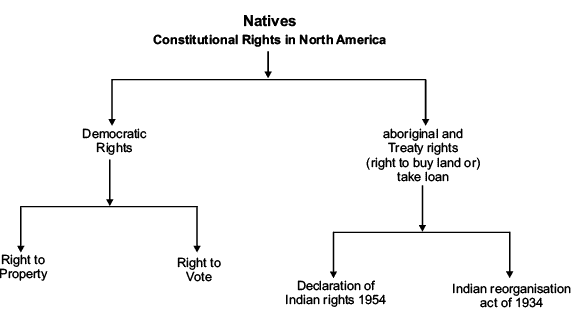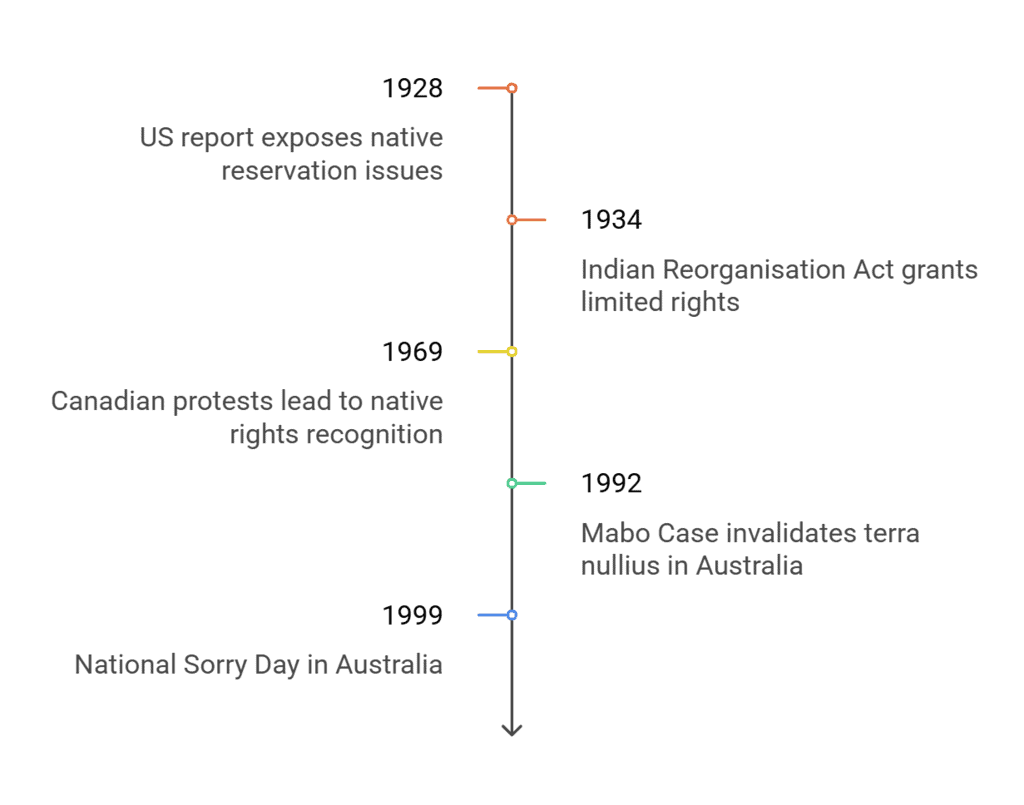Humanities/Arts Exam > Humanities/Arts Notes > History Class 11 > Revision Notes - Displacing Indigenous Peoples
Displacing Indigenous Peoples Revision Notes | History Class 11 - Humanities/Arts PDF Download
1. European Expansion and Colonisation
- From the 18th century, European settlers migrated to North & South America, Australia, New Zealand, and South Africa.
- Native peoples were pushed out, displaced, or assimilated.
- Colonies were European settlements under their "mother country."
- Independent states emerged when colonies gained independence.
- Cultural erasure occurred as native names of rivers and cities (e.g., Ohio, Mississippi, Wollongong) remained, but indigenous presence diminished.
2. European Imperialism & Settler Colonies
Expansion of European Powers
- Spain & Portugal dominated Latin America but did not expand further.
- France, England & Holland expanded into North America, Africa, and Asia.
- The British East India Company controlled South Asia, annexed land, built railways, and taxed landowners.
- In Africa, European presence was initially limited to coastal trade, but full colonisation began in the 19th century.
Settler Colonies and European Domination
- British settlers dominated Australia, Canada, and America.
- Dutch settlers (Boers) controlled South Africa.
- English became the dominant language, except in French-speaking Canada.
3. Native Societies in North America Before Colonisation
Geography and Resources
- North America had diverse landscapes, including the Rocky Mountains, Great Plains, Mississippi River, and Appalachian Mountains.
- The region had abundant natural resources such as forests, oil, gas, and minerals, which played a key role in later industrialisation.
Life of the Indigenous Peoples
- The first inhabitants arrived from Asia via the Bering Strait around 30,000 years ago.
- They relied on hunting, fishing, maize cultivation, and gathering for food.
- There was no private land ownership—land was used communally.
- Trade was based on gift exchange rather than commerce.
- Oral traditions were strong, with rich storytelling, arts, and textiles.

4. European Encounters and Native Displacement
Early Interactions
- Fur and fish trade flourished with native help.
- French traders along the Mississippi found natives engaged in regional trade.
- Europeans introduced alcohol, leading to addiction among natives.
- Tobacco was introduced to Europe by natives.
European Perception of Natives
- Europeans viewed natives as ‘uncivilised’ due to their lack of written language and permanent settlements.
- Rousseau admired them as ‘noble savages’ for their simplicity and purity.
- Wordsworth believed they lacked imagination.
- Washington Irving, who had met natives, described them as humorous and intelligent.
5. Expansion and Native Displacement
Westward Expansion of the USA
- Territorial expansion occurred through the Louisiana Purchase (1803) from France, Alaska’s purchase (1867) from Russia, and the conquest of southwestern USA from Mexico.
- Native inhabitants were not consulted or compensated.
Forced Migration & Conflicts
- In 1832, the US Supreme Court ruled in favor of the Cherokee Nation, but President Andrew Jackson ignored it.
- The Trail of Tears (1838) saw 15,000 Cherokees forcibly removed, with over 25% dying on the way.
- The US-Indian Wars (1865-1890) ended with native groups defeated and confined to reservations.
- In Canada, the Metis Rebellions (1869-1885) were crushed by British authorities.
6. The Impact of European Settlers
Environmental and Economic Changes
- Forests were cleared for agriculture.
- Railways were built for faster settlement and trade.
- Bison were hunted to near extinction by 1890, ending the natives’ hunting-based economy.
Slavery in North America
- Africans were enslaved to work in southern plantations.
- Slavery was abolished in 1865 after the US Civil War, but racial discrimination persisted.
Canadian Expansion
- Canada became a Confederation in 1867.
- French Canadians sought autonomy, leading to self-rule later.
7. Australia’s Colonisation and Indigenous Displacement
Arrival of Europeans
- The Dutch first sighted Australia in 1606.
- In 1770, James Cook claimed it for Britain.
- By 1788, it was used as a penal colony where convicts from Britain were sent.
Effects on Aboriginal Peoples
- 90% of Aborigines died from disease, land loss, and conflicts.
- Land was taken over for sheep farms, wheat farming, and mining.
- Many were forced into hard labor under conditions close to slavery.
- In 1855, Chinese immigration was banned due to racial policies.
8. Indigenous Resistance and Recognition
Resistance Against Colonisation
- Armed uprisings occurred in the USA (1865-1890) but were crushed.
- Canada’s Metis Rebellions (1869-1885) failed.
- Australia had no treaties with natives, and land was simply taken.
Modern Recognition & Apology
- In 1928, a US report exposed poor health and education in native reservations.
- The Indian Reorganisation Act (1934, USA) gave limited land rights to natives.
- In 1969, Canadian protests led to the recognition of native rights in the 1982 Constitution Act.
- In 1992, the Australian High Court ruled in the Mabo Case that terra nullius (land belonging to no one) was invalid.
- In 1999, Australia’s "National Sorry Day" was observed as a formal apology for past injustices.

9. Conclusion: Changing Perceptions of Natives
- Natives, once seen as primitive, are now recognised as communities with distinct cultures and histories.
- There has been a shift towards respecting native rights, land claims, and heritage.
- Museums, literature, and academic research now preserve native histories.
- The transition from colonial oppression to multicultural societies is ongoing in Canada, the USA, and Australia.
Final Takeaways
- European expansion led to the displacement and marginalisation of indigenous peoples.
- Industrialisation and agricultural expansion came at the cost of native lands.
- 20th-century reforms have attempted to restore justice, but challenges remain.
- Native voices, cultures, and histories are now gaining global recognition.
The document Displacing Indigenous Peoples Revision Notes | History Class 11 - Humanities/Arts is a part of the Humanities/Arts Course History Class 11.
All you need of Humanities/Arts at this link: Humanities/Arts
|
27 videos|156 docs|27 tests
|
FAQs on Displacing Indigenous Peoples Revision Notes - History Class 11 - Humanities/Arts
| 1. What were the main motivations behind European expansion and colonization of North America? |  |
Ans. The primary motivations behind European expansion and colonization of North America included the desire for economic gain, the search for new trade routes, the spread of Christianity, and national competition among European powers. Colonizers aimed to exploit natural resources, establish profitable colonies, and spread their cultural and religious beliefs to indigenous populations.
| 2. How did European imperialism affect native societies in North America? |  |
Ans. European imperialism significantly disrupted native societies in North America through land dispossession, the spread of diseases, and cultural assimilation. Native populations faced violence and displacement as settlers expanded their territories, leading to a decline in indigenous populations and the loss of traditional ways of life.
| 3. What role did indigenous resistance play during the colonization process? |  |
Ans. Indigenous resistance was crucial during the colonization process as many Native American tribes actively fought against European encroachment on their lands. Resistance took various forms, including military confrontations, alliances with other tribes, and diplomatic negotiations. This resistance highlighted the resilience of indigenous peoples in the face of colonization.
| 4. What were the consequences of Australia’s colonization on Indigenous peoples? |  |
Ans. The colonization of Australia had devastating consequences for Indigenous peoples, including significant population declines due to violence, disease, and displacement from their lands. The introduction of European land ownership concepts disrupted traditional practices, leading to the loss of cultural identity and connection to the land.
| 5. How have perceptions of indigenous peoples changed in contemporary society? |  |
Ans. Perceptions of indigenous peoples have evolved significantly in contemporary society, with increasing recognition of their rights, cultures, and histories. There is a growing awareness of the injustices faced by indigenous communities due to colonization, leading to movements advocating for reconciliation, land rights, and cultural preservation.
Related Searches

















